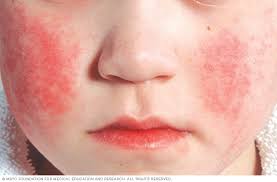 Illness caused by human parvovirus B19.
Illness caused by human parvovirus B19.
Known as erythema infectiosum.
A dermatosis.
The fifth disease with a pink rash to be described after roseola, measles, rubella, and scarlet fever.
Human parvovirus B19, the causative agent.
Spread by respiratory secretions and is highly contagious.
The incubation is from 4 to 14 days but can be as long as 28 days.
Occurs typically in the late winter and early spring.
Typically a disease of early school age children.
Most adults are immune.
In adults without immunity to the virus it can cause an acute self-limited arthritis, thrombocytopenic purpura, aseptic meningitis, encephalopathies, peripheral neuropathies, and myocarditis.
In children with sickle cell anemia or hereditary spherocytosis, this virus may cause an aplastic crisis beginning usually 6 to 8 days after exposure.
In a non-immune pregnant woman it may cause fetal hydrops and stillbirth, but not associated with congenital diseases.
The virus is spread through respiratory droplets and has high secondary infection rates among household contacts.
Most cases are asymptomatic.
The most common clinical presentation is characterized by the classic “slapped cheek” rash.
The rash in adults may be polymorphous and difficult to see on dark skin.
At the onset of the rash patients usually feel well as viremia has resolved.
Most cases are short-lived.
Patients may experience recurrences months after the primary episode.
Infection with parvovirus has been linked to aplastic anemia and, in pregnant females, to miscarriage or hydrops fetalis.
The rash associated with parvovirus infection is likely caused by immune complex deposition in the skin.
Manifests with a prodromal phase of nonspecific symptoms, sometimes mild fever, malaise, myalgias, and headache.
Within a week, the reddened appearance of the face noted as “slapped cheeks” appear.
Following the reddened cheeks is a lacy rash to the trunk and extremities.
The palms and soles are not involved in the rash of Fifths disease.
The process is infectious during the prodromal phase, and is no longer so when the rash appears.
Occasionally the rash may be exacerbated by exposure to heat.
May result in chronic anemia in children and adults.
Serologic diagnosis is usually unnecessary as it is a clinical diagnosis.
Anti-B19 IgM antibodies persists for 2 to 3 months.
Anti-B19 IgG antibodies are detectable a few days after IgM appears and persists for life.
Viral DNA will usually be necessary for diagnosis in the immunocompromised patient.
Seen primarily in school-aged children between 5 and 14 years of age during the spring and winter.
Thought to spread via droplets by respiratory secretions transmitted by coughs and sneezes and blood from other infected people.
Nasal secretions contain the viral DNA.
Blood has been found to contain viral particles as well as DNA.
Can occur either sporadically or as part of community outbreaks.
Outbreaks occur mainly in elementary schools during the spring.
Half of the cases occur in the household, while transmission of the infection in schools is less common.
At least half of adults have had the infection and are unlikely to be re-infected.
About 10% or fewer of young children are immune.
Patients are contagious before the onset of symptoms.
Once rash develops patients are no longer contagious.
